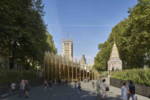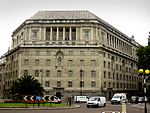Lambeth Bridge

Lambeth Bridge is a road traffic and footbridge crossing the River Thames in an east–west direction in central London. The river flows north at the crossing point. Downstream, the next bridge is Westminster Bridge; upstream, the next bridge is Vauxhall Bridge. The most conspicuous colour in the bridge's paint scheme is red, the same colour as the leather benches in the House of Lords, which is at the southern end of the Palace of Westminster nearest the bridge. This is in contrast to Westminster Bridge, which is predominantly green, the same colour as the benches in the House of Commons at the northern end of the Houses of Parliament. On the east side, in Lambeth, are Lambeth Palace, the Albert Embankment, St. Thomas' Hospital, and the International Maritime Organization. On the west side, in Westminster, are Thames House (the headquarters of MI5), behind which is Horseferry House (the National Probation Service headquarters), and Clelland House and Abell House (the headquarters of HM Prison Service), and the Millbank Tower and Tate Britain. The Palace of Westminster is a short walk downstream to the north through the Victoria Tower Garden.
Excerpt from the Wikipedia article Lambeth Bridge (License: CC BY-SA 3.0, Authors, Images).Lambeth Bridge
Lambeth Bridge, London Millbank
Geographical coordinates (GPS) Address External links Nearby Places Show on map
Geographical coordinates (GPS)
| Latitude | Longitude |
|---|---|
| N 51.494444444444 ° | E -0.12305555555556 ° |
Address
Lambeth Bridge
Lambeth Bridge
SW1P 4PN London, Millbank
England, United Kingdom
Open on Google Maps









